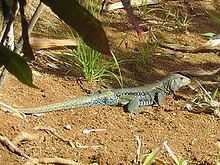Rail lizards
| Rail lizards | ||||||||||||
|---|---|---|---|---|---|---|---|---|---|---|---|---|

Goldteju ( Tupinambis teguixin ) |
||||||||||||
| Systematics | ||||||||||||
|
||||||||||||
| Scientific name | ||||||||||||
| Teiidae | ||||||||||||
| Gray , 1827 |
The rail lizards (Teiidae), also called Tejus , are a family in the class of reptiles (Reptilia).
Occurrence
They occur exclusively in Central and South America. They were introduced into other areas.
anatomy
The length is between eight centimeters and 1.5 meters. They are characterized by a thin, long tail and, like the monitor lizards, by a long, deeply incised tongue that is used for foraging. Your head shields are not fused with the skull bone.
Way of life
What is remarkable about the rail lizards is that in some species only females exist. They do without males and lay eggs without fertilization, from which only females hatch. ( See parthenogenesis )
Some species specialize in a particular food. The Krokodilteju feeds mostly on water snails and lives mostly in water. Others are predominantly ground dwellers and feed on small mammals and insects.
Origin of name
They got the name rail lizards because of their large scales on their belly.
Systematics
- Family rail lizards (Teiidae)
- Subfamily Callopistinae (2 species)
-
Callopistes Gravenhorst, 1838
- Callopistes flavipunctatus (Duméril & Bibron, 1839)
- Chile tegu ( Callopistes maculatus Gravenhorst, 1838)
-
Callopistes Gravenhorst, 1838
- Subfamily Teiinae (> 110 species)
-
Ameiven ( Ameiva Meyer, 1795)
- Green ameive ( Ameiva ameiva )
- Central American Ameive ( Ameiva festiva )
- † Guadeloupe-Ameive ( Ameiva cineracea Barbour & Noble, 1915)
- † Martinique-Ameive ( Ameiva major )
- Ameivula Harvey et al., 2012
- Aspidoscelis Fitzinger, 1843
- Aurivela Harvey et al., 2012
-
Racing lizards ( Cnemidophorus Wagler, 1830)
- Spotted lizard ( Cnemidophorus lemniscatus )
- Six lined lizard ( Cnemidophorus sexlineatus )
- Contomastix Harvey et al., 2012
- Dicrodon Duméril & Bibron, 1839
- Glaucomastix Goicoechea, Frost, De la Riva, Pellegrino, Sites, Rodrigues & Padial, 2016
- Holcosus Cope, 1862
- Kentropyx Spix, 1825
- Medopheos Harvey et al., 2012
- Pholidoscelis Fitzinger, 1843
- Teius Merrem, 1820
-
Ameiven ( Ameiva Meyer, 1795)
- Subfamily Tupinambinae (10 species)
-
Crocodilurus Spix, 1825
- Crocodilurus amazonicus (Spix, 1825)
-
Dracaena Daudin, 1802
- Krokodilteju ( Dracaena guianensis Daudin, 1802)
- Dracaena paraguayensis Amaral, 1950
-
Salvator
- Salvator duseni (Lönnberg, 1896)
- Black and white tegu ( Salvator merianae (Duméril & Bibron 1839))
- Roter Teju ( Salvator rufescens (Günther, 1871))
-
Tupinambis Daudin, 1803
- Tupinambis longilineus Avila-pires, 1995
- Tupinambis palustris Manzani & Abe, 2002
- Tupinambis quadrilineatus Manzani & Abe, 1997
- Goldteju ( Tupinambis teguixin (Linnaeus, 1758))
-
Crocodilurus Spix, 1825
- Subfamily † Polyglyphanodontinae Gilmore 1942
- Subfamily Callopistinae (2 species)
literature
- Gunther Koehler, Bert Langerwerf: Tejus. Way of life, care, breeding. Herpeton, Offenbach 2000, ISBN 3-9806214-3-X .
- Harold Cogger, Richard Zweifel: Encyclopedia of Reptiles & Amphibians. Bechtermünz, Augsburg 1999, ISBN 3-8289-1559-0 .
- Eric R. Pianka, Laurie J. Vitt: Lizards. Windows to the Evolution of Diversity (= Organisms and Environments. Vol. 5). University of California Press Berkeley CA et al. 2003, ISBN 0-520-23401-4 .
Individual evidence
- ↑ Goicoechea, N., Frost, DR, De la Riva, I., Pellegrino, KCM, Sites, J., Rodrigues, MT & Padial, JM: Molecular systematics of teioid lizards (Teioidea / Gymnophthalmoidea: Squamata) based on the analysis of 48 loci under tree alignment and similarity alignment. Cladistics, March 2016, doi: 10.1111 / cla.12150
- ↑ Randall L. Nydam: Polyglyphanodontinae Squamata; Teiidae from the Medial and Late Cretaceous; new taxa from Utah, USA and Baja California del Norte, Mexico. In: David D. Gillette: Vertebrate Paleontology in Utah (= Utah Geological Survey. Miscellaneous Publications. 99-1). Utah Geological Survey, Salt Lake City UT 1999, ISBN 1-55791-634-9 , pp. 303-317, (PDF; 591.97 kB).
